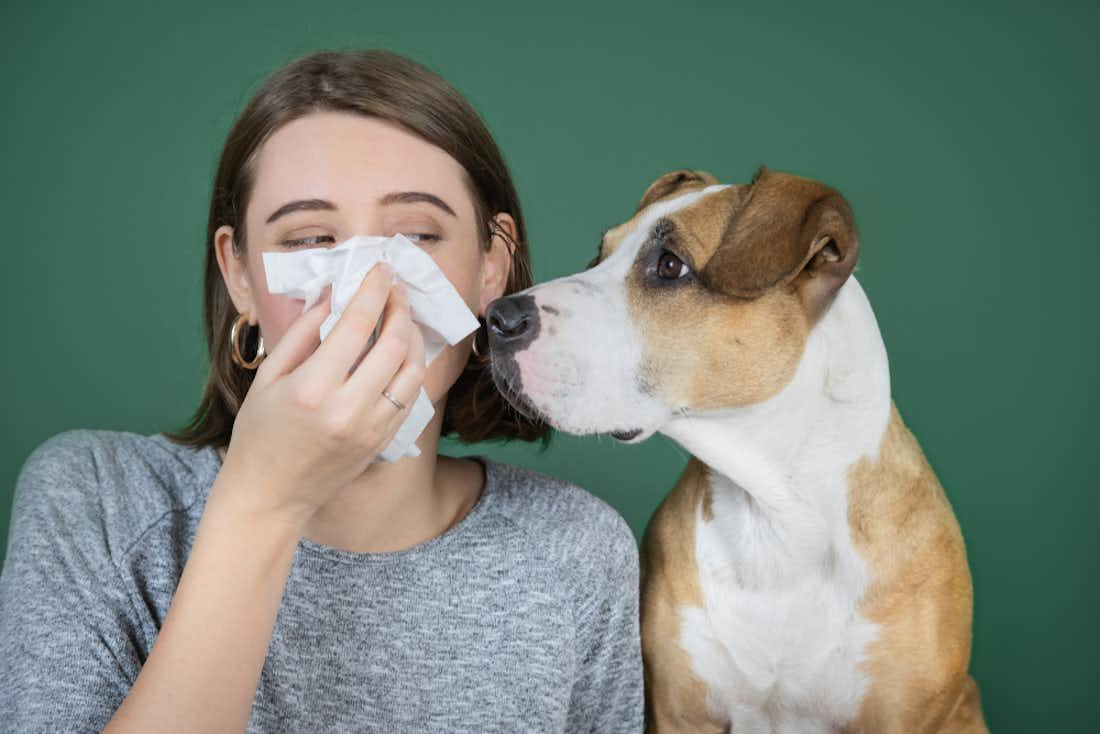Apr 14, 2022
Why Do We Have Allergies in the First Place?
5 minute read
Allergies are frustrating. A runny nose and itchy eyes affect your mood outside, inside, and everywhere in between.
More than 50 million people in the United States have some form of allergy, making it the sixth leading cause of “chronic illness” in U.S.
Oddly enough, the things that cause these allergies aren’t inherently “harmful” in the first place! Pollen, dust mites, milk, and soybeans are just a few examples of common allergens.
If they don’t pose an actual threat to human health, why do so many of us have these reactions?
There are many theories and reasons as to why we might develop allergic reactions in the first place. Let’s take a deep dive and try to understand what exactly causes allergies and what we might be able to do to turn the tide.
What Are Allergies?
An allergic reaction is an abnormal immune system response to a foreign substance.
Your immune system is essentially a shield for your body. It works by attacking foreign invaders, called pathogens, preventing them from damaging your bodily systems while simultaneously working to expel nasty things that might have gotten inside.
Your immune system is incredibly powerful when it comes to getting rid of viruses and bacteria, which do pose a real threat to your health. However, it can be frustrating when a “primed” immune system reacts to harmless substances, releasing a slew of chemicals that lead to an allergic reaction and the symptoms you know as “allergies.”
With an allergy, your body has essentially taken an otherwise benign substance and turned it into a “trigger” for an immune cascade.
The process of developing an allergy begins with “sensitization”, in which an allergen is typically inhaled or internalized. Cells called “antigen presenting cells” in your body recognize proteins on the surface of an allergen, then process and internalize the antigen, finally presenting the same antigen to cells involved in the immune response, including lymphocytes.
In turn, these cells begin to produce “antibodies” to the antigen your body originally recognized as foreign. Antibodies are one way that your body remembers and recognizes foreign pathogens in the future, as these antibodies bind to the same allergens that your body first identified during sensitization. These antibodies persist, preparing your body for a future defense from the allergen.
People with allergies have these specific immunoglobulin E (IgE) antibodies in their blood that recognize and react to a foreign protein.
For instance, if you have a ragweed allergy, you have been sensitized to ragweed pollen and have IgE antibodies that react when re-exposed to ragweed proteins, leading to the symptoms associated with allergies.
When ragweed is recognized once again (every spring, for instance), your body mounts an immune response that includes a flood of chemical messengers released by mast cells, including histamine, prostaglandins, and leukotrienes. These produce all kinds of tissue responses that we associate with an allergic reaction: sneezing and mucus secretion, vasodilatation in the nose leading to a “stuffy” nose, and bronchoconstriction in the lungs leading to wheezing or coughing.
What Are the Symptoms of Allergies?
The symptoms of allergies can differ depending on the cause and severity of your allergic reaction.
Hay fever, also known as allergic rhinitis, is caused by airborne triggers like pollen, dust mites, or pet dander. The symptoms of hay fever** **include:
- Sneezing
- Runny or stuffy nose
- Watery, red, itchy eyes
- Coughing
- Wheezing or other asthma symptoms
Food allergies are another type of allergy that usually involve a different set of symptoms. Food allergy symptoms** **include:
- Swelling of the lips, tongue, or throat
- Hives, or a red, itchy rash
- Difficulty breathing
- Diarrhea or abdominal cramping
- Vomiting and nausea
Contact dermatitis occurs when a substance placed on the skin causes an allergic reaction. The symptoms of contact dermatitis** **include:
- Itchy, red rash
- Blistering or bumps
- Hives
- Flaky or peeling skin
In rare cases, a severe allergic reaction can occur. This is called anaphylaxis, and it occurs when certain foods or substances cause your immune cells to release a flood of chemicals that result in extreme reactions throughout your body.
Symptoms of anaphylaxis can include a severe drop in blood pressure, weak and rapid pulse, severe shortness of breath, lightheadedness or loss of consciousness, nausea and vomiting, or hives. These symptoms require immediate medical attention, and you should call 911 if you suspect anaphylaxis.
So the golden question is, how does something as simple as a peanut cause some people to experience such severe reactions to an allergen?
There are some theories.
Why Do We Even Get Allergies?
Let’s be blunt about it — no one _wants _allergies.
They’re no fun, and they can put a damper on your day. And unfortunately, the scientific jury is still out on exactly why we even get them in the first place.
However, there are a few working theories.
Evolution
One of the most well-respected theories for why allergies exist in the first place hails back to our ancestors. In fact, there’s some evidence that allergy symptoms mimic the same mechanisms that may have saved our ancestors’ lives thousands of years ago.
What do we mean by this?
Let’s take a look at a fairly recent study involving mice. Scientists injected a small dose of honeybee and snakebite venom into rat test subjects. About three weeks later, scientists injected a would-be fatal dose of the same venom into the rats.
Scientists found that the rats who had been injected within small doses initially had much higher chances of survival compared to the rats that hadn’t received the initial injection.
This is because the initial dose allowed rats to produce allergen-specific antibodies (IgE antibodies) to gain a bit of immunity from the venom in case they were to be exposed later on.
The theory posited by the trial is that allergic reactions exist to protect the body from potentially life-threatening dangers by slowly building up a tolerance over time.
This also explains why some people with hypersensitive immune systems experience anaphylaxis — these strong reactions may just be an evolutionary holdover. In other words, it may just be the protective mechanism that would have been advantageous for our ancestors if there was no other form of protection from life-threatening toxins.
As for food allergies, it’s still a little bit less understood. But evolutionary scientists think that certain proteins in foods might remind the immune system of harmful substances related to toxic plants. Therefore, during evolution, our bodies may have “lumped” them into the same category.
A Changing Environment
Another working theory to explain allergy prevalence doesn’t have to do with our past — it has to do with what’s happening in our world right now.
Our day-to-day environments are much cleaner now than they once were, and experts think this might be the culprit.
The “hygiene hypothesis” proposes that childhood exposure to germs and infections helps the immune system develop more tolerance to certain substances. This teaches the body to differentiate between harmless substances (allergens) and harmful substances (viruses and bacteria) that trigger allergies and asthma.
In essence, it is important for children to be exposed to germs and dirt from an early age. Since people are living a more hygienic lifestyle, allergies are becoming more prevalent simply because more people’s immune systems are ill-equipped to handle them.
Scientists fear that the prevalence of allergies will skyrocket due to the COVID-19 pandemic. Since many children spent so much time in isolation and away from others, they were not exposed to pathogens and bacteria the way that children were previously.
Vitamin D Deficiency
Vitamin D is often referred to as the “sunshine vitamin” as it’s an essential vitamin that your body produces naturally from exposure to the sun.
Vitamin D is necessary for building and maintaining healthy bones while also regulating other cellular functions in the body.
But there’s also research to suggest that it can help prevent allergies.
Individuals who live in areas further away from the equator and therefore receive less UV radiation from the sun have been shown to have higher rates of childhood allergy hospital admissions.
It’s also been found that low vitamin D levels are related to an increased risk of allergic sensitization in children and adolescents.
You can get vitamin D by just spending a bit more time in the sun each day (be sure to wear sunscreen) or by eating foods containing vitamin D. Oily fish, eggs, and liver are all rich in this essential nutrient.
Delayed Introduction of Certain Foods
One reason food allergies may be on the rise is due to previous food allergy guidelines that, while well-meaning, may have been misinformed.
In years past, nutritional guidance advised parents to delay children’s introduction to the eight most common food allergens to prevent serious allergic reactions. These eight foods include eggs, milk, shellfish, fish, tree nuts, peanuts, soy, and wheat.
However, a growing body of evidence suggests parents should do the opposite.
Introducing very small amounts of these foods to children during adolescence may help the immune system gain a tolerance to the substance, reducing the risk of a true food allergy later on. It’s similar to the hygiene hypothesis in that it suggests early exposure to triggers may prevent symptoms down the road.
There is no evidence to suggest that delaying the introduction of specific foods beyond six months of age helps prevent food allergies.
However, research does suggest that introducing certain foods between the ages of four to six months may provide a form of protection.
Dual Allergen Hypothesis
Another hypothesis that explains the increase in food allergies is the dual allergen hypothesis.
It posits that sensitization to foods occurs through impaired skin. Essentially, other allergy triggers that contain certain proteins may enter the skin and increase the body’s sensitivity to other substances.
For instance, research has found that peanut allergen proteins have been quantified within household dust mites. Dust mite allergies are common, and early exposure to dust mites might make the body think these proteins are harmful, increasing the risk of developing a serious peanut allergy.
This is one of the less understood theories surrounding allergic reactions. But the basic conclusion is that oral consumption of an allergen can lead to tolerance, whereas skin exposure leads to allergy.
Genetics
If you have allergies now, you might be able to blame your parents. The tendency to develop an allergic reaction seems to be hereditary, though just because a parent has allergies doesn’t mean their children will.
Additionally, someone doesn’t usually inherit a particular allergy — they just become more susceptible to allergies in general. Even more, some kids develop allergies despite their parents having none.
With that said, the chances increase if both parents have allergies. And considering that allergies are on the rise, this might have an exponential effect on the population and continue to make allergies even more abundant.
How Can I Manage Allergies?
So now you know that allergies are on the rise, and you know that there are plenty of different reasons why allergies might happen in the first place.
But are there ways you can stop them in their tracks? Is it possible that we might get to a point where people are not affected by allergies in the slightest?
Patience
If you have a food allergy or even an allergy to an airborne trigger like dust mites or pollen, one thing that works in your favor is that you might be able to outgrow it. Allergies are much more common in children than adults, and some children can outgrow allergies to things like milk or eggs.
However, only about 14% to 20% of children outgrow peanut or tree nut allergies, so this isn’t always the answer.
Your chances of eventually getting rid of your allergy are related to childhood exposure and the number of IgE antibodies in your immune system that may react to a given substance.
Immunotherapy
Allergy immunotherapy is a revolutionary treatment and a major step in the right direction.
Allergy immunotherapy, or AIT, works by gradually exposing your immune system to an allergy over time until your body builds up a tolerance.
It works in the same way that some of the leading allergy theories suggest: exposing the body to small amounts of an allergy trigger so that the immune system can become used to it and therefore be less affected.
Think of it like running an extra 0.25 miles every single day until you’re eventually ready to run a marathon.
Allergy immunotherapy typically involves a series of injections. However, sublingual immunotherapy (SLIT) is a newer form of immunotherapy that involves placing dissolvable tablets under the tongue.
You’ll take your prescribed medication over a period of time recommended by your allergist until, hopefully, your symptoms start to subside when you’re exposed to the allergen.
Sound too good to be true? A robust clinical study involving AIT reported that individuals felt a 78% improvement in productivity, a 90% improvement in general health status, and an 83% improvement in daily energy.
You can take a free allergy quiz from Cleared to see if immunotherapy treatment is right for you.
While it’s too early to tell, if enough people are able to build up a tolerance to their suspected trigger, they may be less likely to transfer that allergy to their children.
In turn, this might decrease the prevalence of allergies across the globe in general.
How Can I Find Relief?
The cause of your allergy symptoms might not mean much to you — you might only care about finding relief from those frustrating symptoms.
We don’t blame you. Here are some of our favorite medicinal options, as well as home remedies, so you can finally breathe clearly.
Antihistamines
Antihistamine medications block the effects of a chemical called histamine, which is released during an allergic reaction and causes many of the associated symptoms.
Oral antihistamines are most common, and these can be taken by mouth to ease common symptoms like coughing, itchy eyes, or sneezing.
However, targeted antihistamine treatments like eye drops or nasal sprays can reduce swelling of the blood vessels and bring more targeted relief to itchy, watery eyes or nasal congestion, respectively.
Most antihistamines can be purchased over the counter, but an allergist can prescribe extra-strength medications for allergies that are just a little too persistent.
Take the free quiz from Cleared to see if you might need something a little more powerful to ease your allergies.
Home Remedies
There are plenty of home remedies that can help to alleviate discomfort. If you have itchy or watery eyes, you might find meaningful relief from something as simple as a cool compress.
Just wet a washcloth with cold water, wring it out to make it damp, and then place it over your eyes to reduce swelling.
If your allergies stem from indoor triggers like dust mites or pet dander, it might be time to do a deep clean of your space.
Wash your sheets, pillows, and linens in hot water to kill off dust mites, then be sure to dry them in a machine rather than hanging them outside. Additionally, be sure to brush your pets often to prevent them from shedding and help keep those pesky hairs from hanging around your rugs or furniture.
Finally, if you’re feeling an itchy or scratchy throat, you might find relief from some hot tea with honey. Anecdotal evidence has shown that honey may be a natural antihistamine and can even reduce symptoms. If all else fails, the hot tea can soothe your throat.
In Conclusion
Allergies are frustrating, and their causes can feel equally frustrating.
Their roots, science suggests, are mostly related to evolution. The most widely used theory is that allergies are the body’s way of defending itself from potentially harmful pathogens later on by equipping the immune system with necessary antibodies to fight off invaders.
However, the hygiene hypothesis states that children are simply living in too clean of a world right now. And since they’re not being exposed to germs and bacteria at a young age, their immune system is ill-equipped and perceives harmless allergens as actually harmful.
Other theories like the dual allergen theory or vitamin D deficiency are also widely accepted. But the truth is, no one really knows exactly why common allergens to harmless substances exist.
The only thing we can do is fight back.
Your online allergist is in and ready to help you turn the tide against allergy triggers and symptoms. Start your free consultation to get personalized treatment and medications delivered straight to your door with Cleared.
Sources
Anaphylaxis - Symptoms and causes | The Mayo Clinic.
Dear Evolution, Thanks for the Allergies | Scientific American
Hygiene hypothesis: Does early germ exposure prevent asthma? | The Mayo Clinic.
Vitamin D and Food Allergy | AAAAI



